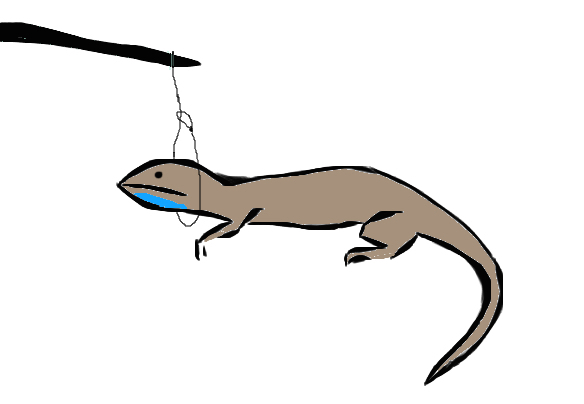A basking lizard is diligent, paranoid, superfast, always near an escape route, and consequently very difficult to catch with bare hands. Most small species have been menu items of larger animals for eons, and they have tuned their fleeing behaviors optimally. Check out the substantial body of literature on lizard flight initiation distance.
But do not despair. This ‘b’log is about solving problems! There’s a very easy way to catch most lizards called a lizard noose—essentially a stick with a looped string on the end. Here’s the recipe:
Materials:
A 2 m or longer stick (or a fishing pole, TV antenna, Phragmites stem, use imagination)
Some dental floss (best with the waxy kind)
A lizard (spiny lizards [genus Sceloporus] are especially catch-able)
Noose Construction:
1) Tie a small loop at the end of a ~10 cm length of floss and string the other end through the loop to make a noose. The wax-covered dental floss works best, because it’s tacky and keeps the noose open.
2) Attach this to the end of your stick.
(Alternative method: I’ve heard of folks simply tying a slip knot on the end of a length of grass and using this. It’s worth a try.)
Technique:
1) Locate a lizard.
2) Get within your stick-length of the lizard. This is usually pretty easy.
3) Gently slip the open noose around the lizard’s neck and slowly pull up on the stick to tighten the loop. It might take few tries if the lizard gets suspicious.
4) Retrieve your captured lizard.
Details:
This works amazingly well. The lizard rarely seems to fear the presence of the stick or floss, even when the noose begins to tighten. Sometimes they even bite at it. It’s also worth noting that a lizard’s tough, scaly dermis protects it from choking or other injury. Species with defined necks are the best candidates for this method. Skinks are sans neck and sometimes too smoothly scaled for easy noosing. Very small anoles may also be difficult, because they have too little mass to pull the noose closed. Alligator lizards are easy to catch, but beware their jaws.
I’m hoping to insert some illustrations soon, but I eager to get the first post published.

